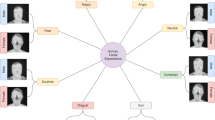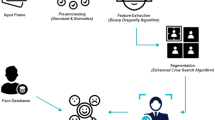Abstract
Facial expression and emotion recognition from thermal infrared images has attracted more and more attentions in recent years. However, the features adopted in current work are either temperature statistical parameters extracted from the facial regions of interest or several hand-crafted features that are commonly used in visible spectrum. Till now there are no image features specially designed for thermal infrared images. In this paper, we propose using the deep Boltzmann machine to learn thermal features for emotion recognition from thermal infrared facial images. First, the face is located and normalized from the thermal infrared images. Then, a deep Boltzmann machine model composed of two layers is trained. The parameters of the deep Boltzmann machine model are further fine-tuned for emotion recognition after pre-training of feature learning. Comparative experimental results on the NVIE database demonstrate that our approach outperforms other approaches using temperature statistic features or hand-crafted features borrowed from visible domain. The learned features from the forehead, eye, and mouth are more effective for discriminating valence dimension of emotion than other facial areas. In addition, our study shows that adding unlabeled data from other database during training can also improve feature learning performance.
Similar content being viewed by others
References
Zeng Z, Pantic M, Roisman G, Huang T. A survey of affect recognition methods: audio, visual, and spontaneous expressions. IEEE Transactions on Pattern Analysis and Machine Intellignece, 2009, 31(1): 39–58
Jarlier S, Grandjean D, Delplanque S, N’Diaye K, Cayeux I, Velazco M, Sander D, Vuilleumier P, Scherer K. Thermal analysis of facial muscles contractions. IEEE Transactions on Affective Computing, 2011, 2(1): 2–9
Ranzato M, Susskind J, Mnih V, Hinton G. On deep generative models with applications to recognition. In: Proceedings of the 2011 IEEE Conference on Computer Vision and Pattern Recognition. 2011, 2857–2864
Wang S, Liu Z, Lv S, Lv Y, Wu G, Peng P, Chen F, Wang X. A natural visible and infrared facial expression database for expression recognition and emotion inference. IEEE Transactions on Multimedia, 2010, 682–691
Khan MM, Ward R D, Ingleby M. Automated classification and recognition of facial expressions using infrared thermal imaging. In: Proceedings of the 2004 IEEE Conference on Cybernetics and Intelligent Systems. 2004, 202–206
Oz I, Khan M M. Efficacy of biophysiological measurements at ftfps for facial expression classification: a validation. In: Proceedings of 2012 IEEE-EMBS International Conference on Biomedical and Health Informatics. 2012, 108–111
Trujillo L, Olague G, Hammoud R, Hernandez B. Automatic feature localization in thermal images for facial expression recognition. In: Proceedings of the 2005 IEEE Conference on Computer Vision and Pattern Recognition. 2005, 14
Jiang G, Song X, Zheng F, Wang P, Omer A M. Facial expression recognition using thermal image. In: Proceedings of the 27th Annual International Conference of the Engineering in Medicine and Biology Society. 2005, 631–633
Hernández B, Olague G, Hammoud R, Trujillo L, Romero E. Visual learning of texture descriptors for facial expression recognition in thermal imagery. Computer Vision and Image Understanding. 2007
Yoshitomi Y. Facial expression recognition for speaker using thermal image processing and speech recognition system. In: Proceedings of the 10th WSEAS International Conference on Applied Computer Science. 2010, 182–186
Pavlidis I, Levine J. Thermal image analysis for polygraph testing. IEEE Engineering in Medicine and Biology Magazine, 2002, 21(6): 56–64
Jain U, Tan B, Li Q. Concealed knowledge identification using facial thermal imaging. In: Proceedings of the 2012 IEEE International Conference on Acoustics, Speech and Signal Processing. 2012, 1677–1680
Liu Z, Wang S. Emotion recognition using hidden Markov models from facial temperature sequence. Lecture Notes in Computer Science, 2011, 6975: 240–247
Eom J S, Sohn J H. Emotion recognition using facial thermal images. Journal of the Ergonomics Society of Korea, 2012, 31(3): 427–435
Bernhard Anzengruber A R. “Facelight”: potentials and drawbacks of thermal imaging to infer driver stress. In: Proceedings of the 4th International Conference on Automotive User Interfaces and Interactive Vehicular Applications. 2012, 209–216
Krzywicki A T, He G, O’Kane B L. Analysis of facial thermal variations in response to emotion: eliciting film clips. In: Proceedings of SPIE Defense, Security, and Sensing. 2009, 7343: 73412-1–73412-11
Merla A, Romani G L. Thermal signatures of emotional arousal: a functional infrared imaging study. In: Proceedings of the 29th Annual International Conference of the Engineering in Medicine and Biology Society. 2007, 247–249
Nhan B R, Chau T. Classifying affective states using thermal infrared imaging of the human face. IEEE Transactions on Biomedical Engineering, 2010, 57(4): 979–987
Ranzato M, Mnih V, Susskind J, Hinton G. Modeling natural images using gated MRFs. IEEE Transactions on Pattern Analysis and Machine Intelligence, 2013
Susskind J M, Hinton G E, Movellan J R, Anderson A K. Generating facial expressions with deep belief nets. Affective Computing, Emotion Modelling, Synthesis and Recognition, 2008, 421–440
Susskind JM. Interpreting faces with neurally inspired generative models. PhD thesis, Department of Psychology, University of Toronto, 2011
Rifai S, Bengio Y, Courville A, Vincent P, Mirza M. Disentangling factors of variation for facial expression recognition. In: Proceedings of 12th European Conference on Computer Vision, 2012, V6: 808–822
Sabzevari M, Toosizadeh S, Quchani S, Abrishami V. A fast and accurate facial expression synthesis system for color face images using face graph and deep belief network. In: Proceedings of the 2010 International Coference on Electronics and Information Engineering. 2010, V2: 354–358
He S, Wang S, Lan W, Fu H, Ji Q. Facial expression recognition using deep Boltzmann machine from thermal infrared images. In: Proceedings of the 2013 Humaine Association Conference on Affective computing and Intelligent Interaction. 2013, 239–244
Kim Y, Lee H, Provost E M. Deep learning for robust feature generation in audio-visual emotion recognition. In: Proceedings of the 2013 IEEE International Conference on Acoustics, Speech and Signal Processing. 2013
Stuhlsatz A, Meyer C, Eyben F, ZieIke T, Meier G, Schuller B. Deep neural networks for acoustic emotion recognition: raising the benchmarks. In: Proceedings of the 2011 IEEE International Conference on acoustics, Speech and Signal Processing. 2011, 5688–5691
Schmidt E M, Scott J J, Kim Y E. Feature learning in dynamic environments: modeling the acoustic structure of musical emotion. In: Proceedings of the International Society for Music Information Retrieval. 2012, 325–330
Martinez H, Bengio Y, Yannakakis G. Learning deep physiological models of affect. IEEE Computational Intelligence Magazine, 2013, 8(2): 20–33
Salakhutdinov R, Hinton G E. Deep Boltzmann machines. In: Proceedings of the 2009 International Conference on Artificial Intelligence and Statistics. 2009, 448–455
Mohamed A, Dahl G E, Hinton G. Acoustic modeling using deep belief networks. IEEE Transactions on Audio, Speech, and Language Processing. 2012
Hinton G E. Training products of experts by minimizing contrastive divergence. Neural Computation, 2002, 14(8): 1771–1800
Petridis S, Martinez B, Pantic M. The mahnob laughter database. Image and Vision Computing Journal, 2013, 31(2): 186–202
Selinger A, Socolinsky D A. Appearance-based facial recognition using visible and thermal imagery: a comparative study. Technical report, DTIC Document, 2006
Otsu N. A threshold selection method from gray-level histograms. IEEE Transactions on Systems, Man and Cybermetics, 1979, 9(1): 62–66
He X, Yan S, Hu Y, Niyogi P, Zhang H J. Face recognition using laplacianfaces. IEEE Transactions on Pattern Analysis and Machine Intelligence, 2005, 27(3): 328–340
Wright J, Yang A, Ganesh A, Sastry S, Ma Y. Robust face recognition via sparse representation. IEEE Transactions on Pattern Analysis and Machine Intelligence, 2009, 31(2): 210–227
Author information
Authors and Affiliations
Corresponding author
Additional information
Shangfei Wang received her BS in electronic engineering from Anhui University, China in 1996. She received her MS in circuits and systems, and the PhD in signal and information processing from University of Science and Technology of China (USTC), China in 1999 and 2002. From 2004 to 2005, she was a postdoctoral research fellow in Kyushu University, Japan. Between 2011 and 2012, Dr. Wang was a visiting scholar at Rensselaer Polytechnic Institute in Troy, USA. She is currently an associate professor of School of Computer Science and Technology, USTC. Dr. Wang is an IEEE and ACM member. Her research interests cover computation intelligence, affective computing, and probabilistic graphical models. She has authored or co-authored over 70 publications.
Menghua He received her BS in information and computation science from Anhui University, China in 2011. She is currently pursuing her MS in computer science at the University of Science and Technology of China, Hefei, China. Her research interesting is affective computing.
Zhen Gao received his BS in computer science from Nanjing University of Science and Technology in 2013, and he is currently pursuing his MS in computer science in the University of Science and Technology of China, Hefei, China. His research interesting is affective computing.
Shan He received his BS in computer science from Anhui Agriculture University, China in 2010. He received his MS in computer science in the University of Science and Technology of China (USTC), China in 2013. He is currently a researcher of iFLYTEK research.
Qiang Ji received his PhD in electrical engineering from the University of Washington. He is currently a professor with the Department of Electrical, Computer, and Systems Engineering at Rensselaer Polytechnic Institute (RPI). He recently served as a program director at the National Science Foundation (NSF), where he managed NSF’s computer vision and machine learning programs. He also held teaching and research positions with the Beckman Institute at University of Illinois at Urbana-Champaign, the Robotics Institute at Carnegie Mellon University, the Dept. of Computer Science at University of Nevada at Reno, and the US Air Force Research Laboratory. He currently serves as the director of the Intelligent Systems Laboratory (ISL) at RPI.
Prof. Ji’s research interests are in computer vision, probabilistic graphical models, information fusion, and their applications in various fields. He has published over 160 papers in peer-reviewed journals and conferences. His research has been supported by major governmental agencies including NSF, NIH, DARPA, ONR, ARO, and AFOSR as well as by major companies including Honda and Boeing. He is an editor on several related IEEE and international journals and he has served as a general chair, program chair, technical area chair, and program committee member in numerous international conferences/workshops. Prof. Ji is a fellow of IAPR.
Rights and permissions
About this article
Cite this article
Wang, S., He, M., Gao, Z. et al. Emotion recognition from thermal infrared images using deep Boltzmann machine. Front. Comput. Sci. 8, 609–618 (2014). https://doi.org/10.1007/s11704-014-3295-3
Received:
Accepted:
Published:
Issue Date:
DOI: https://doi.org/10.1007/s11704-014-3295-3




